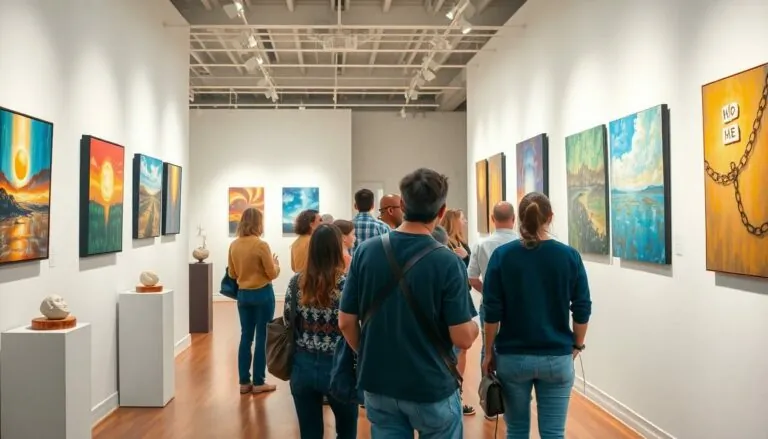Table of Contents
ToggleIn the world of art, beauty often steals the spotlight, leaving its quirky cousin—ugly painting—shivering in the shadows. But what if embracing the bizarre could spark a revolution in creativity? Ugly paintings challenge conventional aesthetics, turning heads and raising eyebrows. They’re like that one friend who shows up to a party wearing socks with sandals—unexpected but undeniably memorable.
These unconventional masterpieces invite viewers to question their perceptions of beauty. They provoke thought, laughter, and sometimes even a little confusion. In a society obsessed with perfection, ugly painting dares to be different, reminding us that art isn’t just about pretty pictures; it’s about expression, emotion, and maybe a touch of chaos. So, let’s dive into the wonderfully weird world of ugly painting and discover why these unconventional creations deserve a place on your wall and in your heart.
Understanding Ugly Painting
Ugly painting defies conventional aesthetics, prompting viewers to question their understanding of beauty. This unique art form reflects a broader conversation about expression and emotion in visual work.
Definition of Ugly Painting
Ugly painting encompasses artworks that intentionally deviate from traditional ideals of beauty. Artists may use distorted forms, clashing colors, or unsettling subjects to evoke strong emotional reactions. Such pieces challenge viewers to engage with uncomfortable feelings and rethink their perceptions of art. By prioritizing raw expression over visual appeal, ugly paintings highlight the complexity of human experience.
Historical Context
The roots of ugly painting trace back to various artistic movements across history. Expressionism, emerging in the early 20th century, emphasized emotional depth over beauty and influenced many subsequent artists. This movement paved the way for contemporary examples, where the notion of beauty became increasingly subjective. Notably, modern art movements such as Dadaism and Abstract Expressionism celebrated chaos and disorder, aligning with the principles of ugly painting. Throughout art history, embracing the unconventional served as a powerful means of challenging societal norms.
Notable Artists in Ugly Painting

Ugly painting features several notable artists who have made significant contributions to this unconventional art form. These artists challenge aesthetic ideals through their unique styles and perspectives.
Key Figures
Francis Bacon stands out with his visceral depictions of the human condition, often using distorted figures and unsettling imagery. Jean-Michel Basquiat utilizes raw expression and vibrant colors, creating a sense of chaos that reflects social commentary. Another key figure, Paul Klee, employs abstraction and unexpected color combinations that invite viewers to reconsider notions of beauty. Each artist embraces the ugly, creating works that provoke thought and discussion while rejecting traditional beauty standards.
Influential Works
Bacon’s “Three Studies for Figures at the Base of a Crucifixion” exemplifies discomfort in form and execution. Basquiat’s “Untitled (Skull)” captures the essence of urban struggles through chaotic brushstrokes and vivid contrasts. Klee’s “Twittering Machine” presents a whimsical yet unsettling approach, blending humor with discomfort. These works highlight the emotional depth and complexity of ugly painting, encouraging viewers to engage with the uncomfortable.
Techniques and Styles
Ugly painting employs various techniques and styles that challenge traditional aesthetics. These methods often evoke strong emotional responses, engaging viewers on a deeper level.
Common Techniques
Artists frequently utilize distortion in their work, manipulating shapes and proportions to create unsettling figures. Clashing colors also play a crucial role, as they disrupt visual harmony and prompt visceral reactions. Textural elements such as thick brush strokes or drips contribute to a sense of chaos, adding to the overall impact. Many artists choose unconventional materials, mixing media to create layered, complex compositions. These techniques collectively enable ugly paintings to push boundaries and provoke thought.
Unique Styles
Expressionism stands out among the styles associated with ugly painting, emphasizing raw emotion and subjective experience. Dadaism, with its emphasis on absurdity and anti-art sentiment, embraces chaos and often rejects traditional beauty. Abstract Expressionism offers a unique perspective, focusing on spontaneous expression through abstract forms. Contemporary artists often blend styles, incorporating elements from multiple movements to create individual interpretations. Each unique style offers a distinct approach, enriching the dialogue surrounding beauty in art.
The Impact of Ugly Painting
Ugly painting significantly influences both culture and viewer perceptions. Its unconventional approach challenges standard notions of beauty, inviting deeper reflection and dialogue.
Cultural Influence
Art movements like Dadaism, Expressionism, and Contemporary art often embrace the principles of ugly painting. These movements inspire artists to explore themes of chaos and rebellion against norms. Historically, ugly painting has pushed the boundaries of acceptable aesthetics, prompting society to reconsider established standards. Current artists, influenced by these movements, create works that provoke conversation and breakdown traditional views. Society benefits from this artistic exploration, leading to a more inclusive understanding of beauty that values emotional expression over perfection.
Viewer Reception
Responses to ugly painting vary widely among audiences. Some viewers appreciate the raw emotional engagement and thought-provoking nature of the art. Others express discomfort, struggling with the rejection of traditional beauty. Audience reactions often spark discussions about personal perceptions of aesthetics. Emotional responses may lead to a deeper understanding of complex human experiences reflected in the artworks. Ultimately, ugly paintings challenge viewers to confront their preferences and biases, facilitating personal growth through art.
Ugly painting serves as a powerful reminder that art transcends conventional notions of beauty. By embracing the unconventional and the uncomfortable, it invites viewers to engage with deeper emotional truths. This art form challenges societal standards and encourages a broader appreciation for diverse expressions of creativity.
As contemporary artists continue to explore and redefine aesthetics, ugly painting remains a vital part of the conversation. It pushes boundaries and inspires reflection on personal biases toward beauty. Ultimately, ugly painting enriches the art world, proving that even the most unconventional works can hold profound significance.







